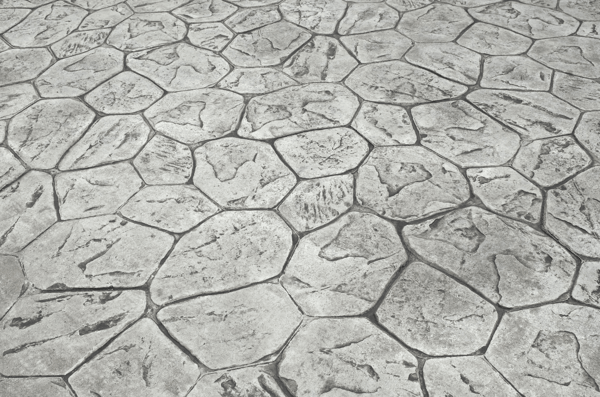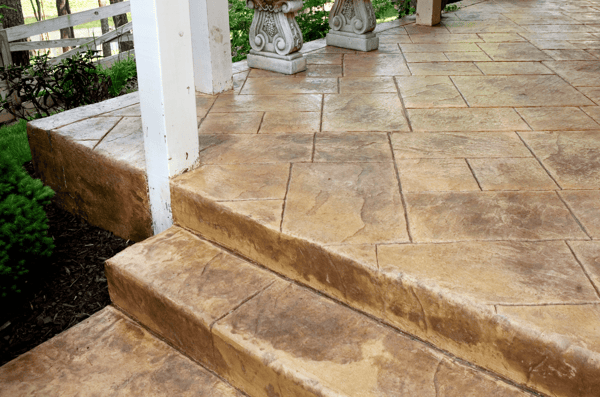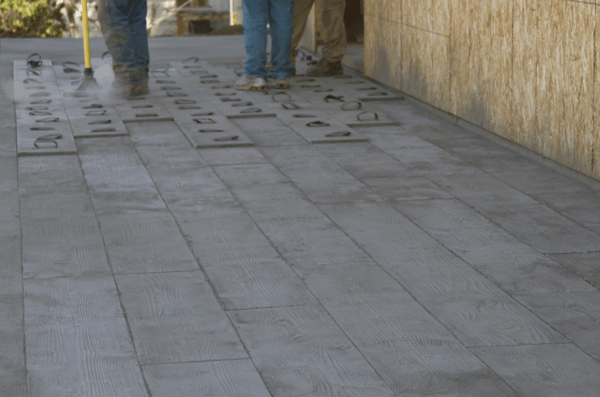The stamped concrete compound annual growth rate (CAGR) for 2020-2025 will likely exceed 6%. Refurbishing and remodeling in combination with a high demand for stamped concrete flooring are contributing factors.
When adding a driveway, walkway, patio, or other concrete surface stamped concrete is a modern way to give the area a decorative look at a reasonable price. If you are wondering what stamped concrete is or what the installation process is, keep reading.

What is Stamped Concrete?
Stamped Concrete is a concrete application that through the addition of patterns, colors and texture provides a classier, more decorative look to your property. It may resemble tile, brick, stone, or any other custom design.
This wonderful artsy looking concrete is durable and can be used for a wide variety of applications both outside and inside your home. Some of the best information available can be found at the World of Concrete. This annual event showcases the latest developments and the new and best ways of completing this process. The show began in 1975 and has grown to a 700,000 square foot show scheduled for June 2021 at the Las Vegas Convention Center.
Patterns
Stamping of concrete is done through the use of texturizing mats or rubber stamps to create a pattern in wet cement. Quite often the stamps are made using real materials to perfect the look.
Popular stamped concrete patterns include brick, slate, wood planks, cobblestone, and more. Custom looks include the embedding of medallions or other accents to give your stamping a unique look. The most popular patterns include:
- London Cobble—a lightly textured traditional cobblestone pattern
- Fractured Cyprus Slate—heavy texture with joints having a fractured split edge
- Ashlar Cut Slate—an Ashlar pattern on stones with a slate surface
- Grand Ashlar—various sizes and shapes of stones with a slate texture laid in an Ashlar pattern
- Random Stone—a look of heavily textured fieldstones
- Classic Wood—a look of six-inch-wide planks combining multiple wood grains
- European Fan—slightly curved rectangular slat stones in a European fan pattern
- Stones of Athens—the look of ancient Greece through the use of granite, marble, and limestone next to each other
- Running Bond New Brick—smooth joints in a running bond pattern of brick
- Herringbone New Brick—the use of sharp corners and a few irregularities or indentions on the surface of a wire-cut common trick texture
- Rough Stone Texture—a continuous course surface with the look of a natural stone texture
- Sanded Slate Texture—the appearance of slate texture that has a lightly sanded appearance
In addition to these popular styles, most contractors of stamped concrete have their own patterns and textures that are custom to their company or popular in their area.
Colors
When stamping concrete you want to add color that looks natural. There is a wide range of colors that will provide realism to your chosen design. When making a color selection consider the other elements in the area to provide a natural blend.
Earth tones are usually the best choice for outdoor applications:
- Red—terra cotta or mahogany
- Brown—ranges run from light tan to deep walnut
- Grey—can be dark like charcoal or replicate light stones
To achieve tone variations you apply at least one accent color using hardener, acid stain, or tinted release agents. To achieve a bold look layer dyes or water-based stains that come in vibrant colors.

Popular Outside Applications
Stamped concrete designs can be placed horizontally or vertically, making them an ideal accent for dressing up your outside entertaining area. Imagine your flower gardens enclosed with a stamped concrete border that coordinates with the design on your concrete outdoor fireplace.
Maybe you will add a cement retaining wall that resembles brick. Poolside benches can be stamped to look like wood. The possibilities are endless to give you a durable and decorative outside entertainment area.
Stamped Concrete Patio
Stamped concrete sets everything a step above the rest, whether a patio, garden edge, or pool surround. The stamping process is the same no matter which concrete pattern you want. There are many benefits to this type of application that give you a maintenance-easy and attractive look.
Imagine that beautiful blend of concrete patterns in your yard as you ensure privacy with stamped concrete fencing in a wood pattern. Then add a beautiful slate patio surrounding your concrete pool.
Stamped Concrete Driveway
A stamped concrete driveway will give the home an elegant appearance. Select patterns and colors that coordinate with the outside of the home. In addition to the drive, a coordinating stamped walkway leading to the entryway adds additional eye-appeal.
Inside Flooring
The average homeowner thinks about stamped concrete for outdoor applications, but it is a very decorative and cost-effective treatment to use inside the home. When working with a concrete floor it is important to select the proper grinder for polishing concrete floors, stone floors, and wood surfaces.
For decorative flooring in the basement consider stamped concrete in a color and pattern to look like wood. This provides versatile flooring with a visual feeling of warmth. Patterns and designs for stamped concrete create attractive flooring for every room in the home.
A stamped concrete entryway provides an elegant, durable floor in a custom color in a tile, slate, or wood pattern to suit the style of the home. Other ideal areas for this type of flooring are the bathroom and kitchen, where a tile design is popular.
When working with machinery for stamped concrete, you may have questions. Even simple things like changing sander vacuum bags or handle grips can cause a glitch. We invite you to check out the OnFloor Technologies Flooring Tutorials for great how-to information.

How to Install Stamped Concrete
Stamped concrete is an easy application if you have the correct tools for working with concrete. The basic steps are as follows:
1. Pour cement no less than 4” thick
2. Add the primary color through one of two methods
- Integral—adding color in the mixer
- Broadcast or Surface Coloring—adding color after cement placement, meaning color must be evenly spread across the wet cement surface
3. Apply color release agent—the accent color that provides dimension and has a nonstick effect allowing texturizing mats to pull off without damaging the cement
4. Lay texturizing mats—must be done while cement is wet so you will need to apply and then move to cover the entire surface, making sure to line up continuous pattern lines
5. Dry—cement must dry for 24 hours
6. Pressure wash— to remove the release agent
7. Clear sealing—add and let dry
8. Surface should be sufficiently dry to walk on after 48 hours and to drive on after a week; cement is fully cured after one month
Anyone who is looking to increase their skill in stamping concrete or building their business in this area will want to join the largest gathering of expert trainers from around the world at the Concrete Décor Show. This event full of training workshops and seminars to provide you with everything you need to know about improving techniques and increasing sales.
The Low-Maintenance Upgrade
Stamped concrete is a great low-maintenance, highly durable option that adds decorative appeal to businesses and residential properties at a low cost. Whether shopping for your business or looking to provide a client with up-to-date information, it is an excellent choice for indoor and outdoor applications.
Here at OnFloor Technologies, we are here to help with all your stamped concrete needs. We invite you to check out our website and contact us at 877-356-6703 with any questions you may have.

12 comments